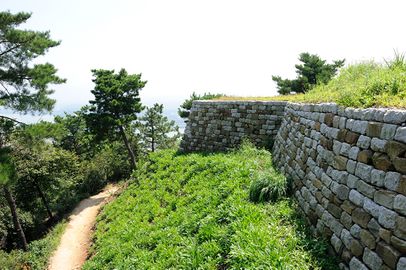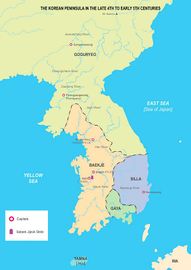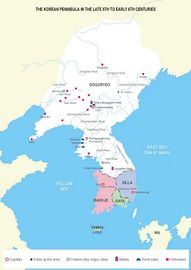"The Furnace of the Korean Peninsula - The Three Kingdoms Period"의 두 판 사이의 차이
| (같은 사용자의 중간 판 5개는 보이지 않습니다) | |||
| 2번째 줄: | 2번째 줄: | ||
|Article= 한반도의 용광로, 삼국시대 | |Article= 한반도의 용광로, 삼국시대 | ||
}} | }} | ||
| + | |||
| + | The Three Kingdom’s period refers to the time between the 1st century BCE until the 7th Century CE on the Korean peninsula and extending into Manchuria (in present-day China and Russia). At the beginning of this period, the southern part of the peninsula was occupied by tens of local city-states organized into three confederacies: Mahan (southwest), Jinhan (southeast), and Byeonhan (mid-south), collectively referred to as the Samhan (lit. “three han”). Meanwhile, in the northern part of the peninsula and extending into Manchuria were various kingdoms, including Buyeo (far north), Okjeo (far northeast), Dongye (mid-east), and [[Goguryeo]] (north). By the 4th century CE, as local city-states consolidated power in each region, Mahan, Jinhan, and Byeonhan would develop into the kingdoms of [[Baekje]], [[Silla]] and [[Gaya]], respectively, while northern kingdoms were consolidated by [[Goguryeo]]. It was around this time that Buddhism was introduced to the peninsula, becoming the official religion of the kingdoms. By the end of the 5th century, [[Goguryeo]] extended far into Manchuria and left only the southern-most regions of the peninsula to [[Baekje]], [[Gaya]], and [[Silla]]. In the mid-6th century, [[Silla]] fully conquered [[Gaya]] and made territorial gains in the Hangang River basin at the expense of [[Goguryeo]]. After further territorial struggles between [[Goguryeo]], [[Baekje]], and [[Silla]] (the three kingdoms from which the period gets its name) from the late 6th until the mid-7th century, Silla was able to weaken [[Baekje]] and [[Goguryeo]] through an alliance with Tang China and consolidated the southern two-thirds of the peninsula into what is known as Unified [[Silla]] in 676. Information on these periods can be found in the ''[[History of the Three Kingdoms]]'' and ''[[Memorabilia of the Three Kingdoms]]'', from the 12th and 13th centuries, respectively. | ||
| + | |||
| + | <gallery mode=packed heights=180px> | ||
| + | 파일:1-3.정림사_탑-ESC_9265.jpg| Five-Story Stone Pagoda of Jeongnimsa Temple, built during Baekje (National Treasure No. 9; Dongnam-ni, Buyeo-eup, Buyeo-gun, Chungcheongnam-do) | ||
| + | 파일:5-3.첨성대_Cheomseongdae_Observatory.jpg| Cheomseongdae Observatory, an astronomical observatory built in Silla at the end of the Three Kingdoms period by [[Queen Seondeok]] (National Treasure No. 31; Gyeongju, Gyeongsangbuk-do). | ||
| + | 파일:1-4.아차산성-FSC_0132.jpg|Achasanseong Fortress from the Goguryeo period (Gwangjang-dong, Gwangjin-gu, Seoul) | ||
| + | </gallery> | ||
| + | |||
| + | <gallery mode=packed heights=180px> | ||
| + | File:002(E).jpg|Proto Three Kingdoms | ||
| + | File:003(E).jpg|Three Kingdoms - Late 4CE-Early 5CE | ||
| + | File:004(E).jpg|Three Kingdoms - Late 5CE-Early 6CE | ||
| + | File:005(E).jpg|Three Kingdoms - Mid 6CE-Early 7CE | ||
| + | File:016(E).jpg|Spread of Buddhism | ||
| + | File:037(E).jpg|Gaya's International Trade | ||
| + | </gallery> | ||
=='''Related Articles'''== | =='''Related Articles'''== | ||
| 15번째 줄: | 32번째 줄: | ||
*[[Buddhism]] | *[[Buddhism]] | ||
*[[Nadang War]] | *[[Nadang War]] | ||
| − | *'' | + | *[[History of the Three Kingdoms|''History of the Three Kingdoms (三國史記, Samguk sagi)'']] |
| − | *'' | + | *[[Memorabilia of the Three Kingdoms|''Memorabilia of the Three Kingdoms (三國遺事, Samguk yusa)'']] |
=='''References'''== | =='''References'''== | ||
<references/> | <references/> | ||
| − | [[Category:Overview of Korean History]] | + | [[Category:An Overview of Korean History]] |
2017년 11월 23일 (목) 10:06 기준 최신판
The Three Kingdom’s period refers to the time between the 1st century BCE until the 7th Century CE on the Korean peninsula and extending into Manchuria (in present-day China and Russia). At the beginning of this period, the southern part of the peninsula was occupied by tens of local city-states organized into three confederacies: Mahan (southwest), Jinhan (southeast), and Byeonhan (mid-south), collectively referred to as the Samhan (lit. “three han”). Meanwhile, in the northern part of the peninsula and extending into Manchuria were various kingdoms, including Buyeo (far north), Okjeo (far northeast), Dongye (mid-east), and Goguryeo (north). By the 4th century CE, as local city-states consolidated power in each region, Mahan, Jinhan, and Byeonhan would develop into the kingdoms of Baekje, Silla and Gaya, respectively, while northern kingdoms were consolidated by Goguryeo. It was around this time that Buddhism was introduced to the peninsula, becoming the official religion of the kingdoms. By the end of the 5th century, Goguryeo extended far into Manchuria and left only the southern-most regions of the peninsula to Baekje, Gaya, and Silla. In the mid-6th century, Silla fully conquered Gaya and made territorial gains in the Hangang River basin at the expense of Goguryeo. After further territorial struggles between Goguryeo, Baekje, and Silla (the three kingdoms from which the period gets its name) from the late 6th until the mid-7th century, Silla was able to weaken Baekje and Goguryeo through an alliance with Tang China and consolidated the southern two-thirds of the peninsula into what is known as Unified Silla in 676. Information on these periods can be found in the History of the Three Kingdoms and Memorabilia of the Three Kingdoms, from the 12th and 13th centuries, respectively.
Cheomseongdae Observatory, an astronomical observatory built in Silla at the end of the Three Kingdoms period by Queen Seondeok (National Treasure No. 31; Gyeongju, Gyeongsangbuk-do).
Related Articles
- Goguryeo
- Baekje
- Silla
- Three Kingdoms
- Gaya
- Samhan Confederacies
- Buyeo
- Okjeo
- Dongye
- Buddhism
- Nadang War
- History of the Three Kingdoms (三國史記, Samguk sagi)
- Memorabilia of the Three Kingdoms (三國遺事, Samguk yusa)








